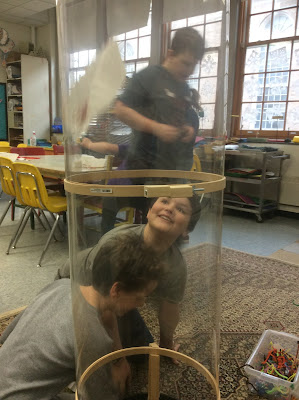Thanks to the marvel that is Exploratorium's web presence, it wasn't too hard to figure out how to make one for myself with these directions. With the convenience of online shopping and generously shared acetate from Samantha Spisiak at Wildflower Studio, I had my supplies together within a couple of days.
Why does an art teacher need a wind tube? Because artists are the original scientists. We like to tinker, experiment with materials, build interesting shapes and designs, and see what happens. We also like our stuff to look great, too. And if my class can be the entry point for either budding artists to learn and love science, or for science-minded kids to love art, well then I have won at the whole interdisciplinary teaching game.
Let me just tell you, when kids came in and saw a balloon levitating in my class room, mysteriously and wondrously hovering in a funnel of wind, they wanted more. No child, not one soul, asked what the art teacher was doing with a wind tunnel.
By contrast, when I brought it to my son's school for the Maker Faire this week, an adult asked me what I teach. I said art. It worries adults when we don't fit in boxes. He looked puzzled, disappointed, and then irritated as he demanded to know, Well, why not science?
Because I love all the subjects, I said. Because if I teach art, I can teach everything. I can blend art and science and writing and math and movement and more. It's all there in the art room.
Now, you might argue it's all there in science, too, and I sure hope you are right. We are a weird system of silos in public American education, so I hope more and more teachers are broadening their approach. In art, 5th graders had twenty minutes to lift a little plastic sea creature out of the tunnel using a selection of materials. The challenge, which the kids didn't know, was that no single item would work alone.
The students had coffee filters, strawberry baskets, paper bags, cardboard tubes, string, pipe cleaners, tape, and small plastic bags. They also had markers and crayons, because, you know, aesthetics.
The coffee filter, which looks like a parachute, seemed the obvious choice for most students, who worked in pairs. But a single coffee filter did not catch enough air to provide the needed lift.
That when you go back, redesign, and try again. Just as we were running out of time, along comes this guy:
Quietly, thoughtfully, confidently, he connected five coffee filters at varying heights to a single plastic octopus. It flew right out of the tube, all the way to the ceiling. The other students were floored. One great thing about varying what and how I teach is that it lets different students shine in ways that excite and surprise the class. He got applause.
This is engineering. What does this have to do with art? Good art needs a good engineer. You don't want your sculptures to topple over, and you want that windsock to fly. Engineering is a basic skill that can build into many life directions. Science is one. Art is one, too.
Unlike the sea creatures, my son was a bit heavy to lift out of it, no matter how many little parachutes we attached to him. Every design has it's limitations.
Oops. Forgot the fan. Maybe more wind next time.







No comments:
Post a Comment